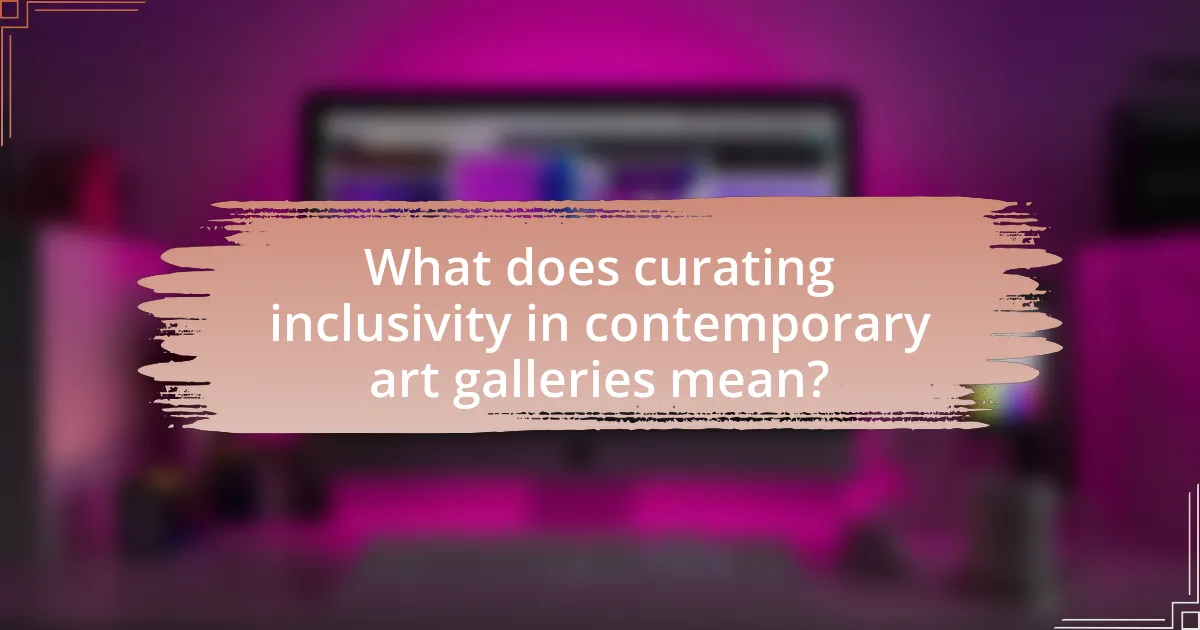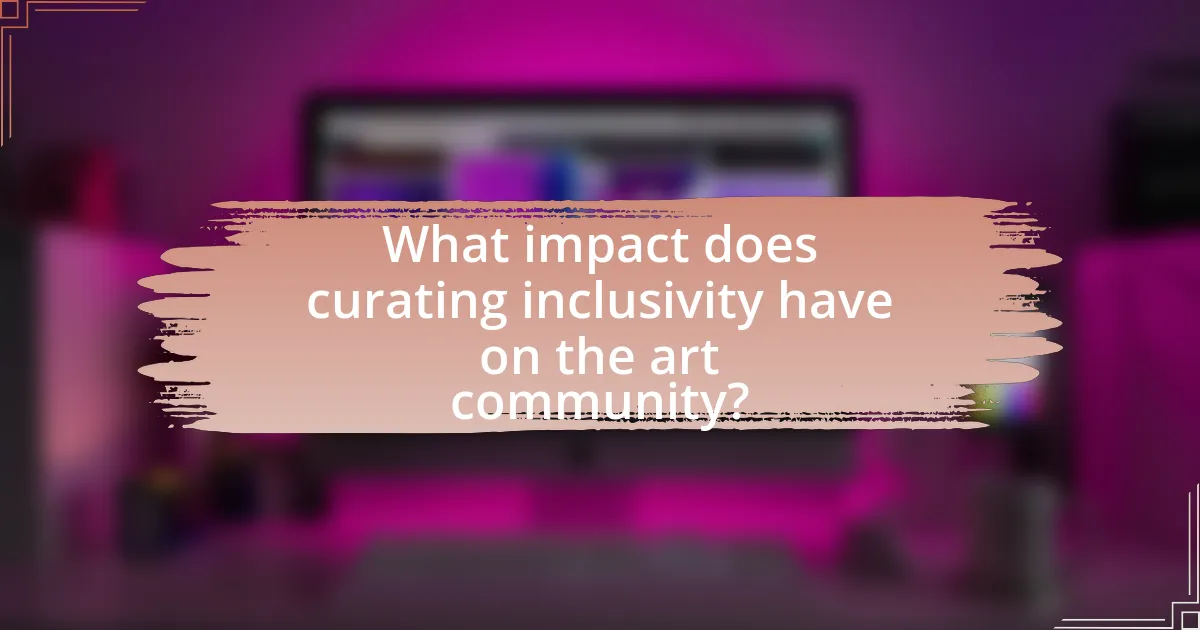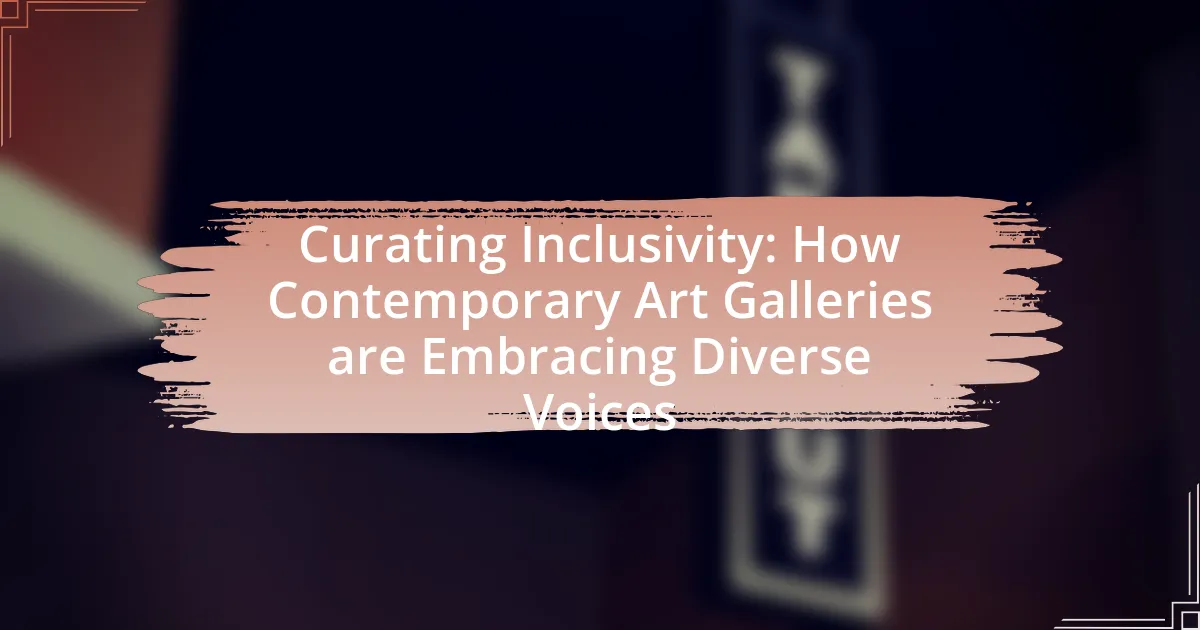Curating inclusivity in contemporary art galleries involves the intentional selection and presentation of artworks that reflect diverse perspectives, backgrounds, and experiences. This approach aims to enhance audience engagement and foster a comprehensive understanding of contemporary issues by showcasing underrepresented artists from various ethnicities, genders, and socioeconomic statuses. The article explores how galleries implement inclusive curatorial practices, the criteria for selecting diverse artists, the impact of representation on audience experience, and the historical context that has shaped the current focus on inclusivity. Additionally, it addresses the challenges galleries face in promoting inclusivity and highlights best practices for effectively engaging with diverse communities.

What does curating inclusivity in contemporary art galleries mean?
Curating inclusivity in contemporary art galleries means intentionally selecting and presenting artworks that reflect diverse perspectives, backgrounds, and experiences. This approach aims to create an environment where underrepresented artists, including those from various ethnicities, genders, and socioeconomic statuses, are given visibility and a platform to share their narratives. Research indicates that inclusive curation can enhance audience engagement and foster a more comprehensive understanding of contemporary issues, as seen in initiatives like the 2019 Venice Biennale, which featured a record number of women and artists from marginalized communities.
How are diverse voices represented in contemporary art galleries?
Diverse voices are represented in contemporary art galleries through inclusive curatorial practices that prioritize artists from various backgrounds, including marginalized communities. Many galleries actively seek to showcase works by artists of different ethnicities, genders, sexual orientations, and abilities, reflecting a broader spectrum of human experience. For instance, exhibitions like “The Black Index” at the Museum of Contemporary Art in Los Angeles highlight the contributions of Black artists, while initiatives such as the “Women’s Art Registry” promote female artists. These efforts are supported by statistics indicating that galleries with diverse programming attract wider audiences and foster community engagement, demonstrating the importance of representation in the art world.
What criteria are used to select diverse artists and artworks?
Diverse artists and artworks are selected based on criteria that include representation of various cultural backgrounds, artistic innovation, and social relevance. Art galleries prioritize artists who reflect underrepresented communities, ensuring a broad spectrum of perspectives is showcased. Additionally, the selection process often evaluates the originality of the artwork and its ability to engage with contemporary social issues, thereby fostering dialogue and awareness. This approach is supported by initiatives aimed at promoting inclusivity in the arts, which have been documented in various studies highlighting the importance of diversity in cultural representation.
How does representation impact the audience’s experience?
Representation significantly enhances the audience’s experience by fostering a sense of belonging and validation among diverse groups. When contemporary art galleries showcase a variety of voices and perspectives, they create an environment where individuals can see their identities and experiences reflected in the art. This inclusivity not only enriches the cultural dialogue but also encourages engagement and emotional connection with the artwork. Research indicates that diverse representation in art can lead to increased attendance and participation from underrepresented communities, as evidenced by studies showing that galleries with inclusive programming attract a broader audience demographic.
Why is inclusivity important in the art world?
Inclusivity is important in the art world because it fosters a richer and more diverse cultural landscape. By embracing a variety of perspectives, backgrounds, and experiences, the art world can reflect the complexities of society, allowing for a broader range of narratives and ideas to be expressed. Research indicates that diverse teams produce more innovative outcomes; for instance, a McKinsey report found that companies with higher diversity levels are 35% more likely to outperform their peers. This principle applies to art galleries as well, where inclusivity can lead to more engaging exhibitions that resonate with wider audiences, ultimately enhancing the relevance and impact of contemporary art.
What historical context has led to the current focus on inclusivity?
The current focus on inclusivity in contemporary art galleries stems from historical movements advocating for civil rights and social justice, particularly during the 20th century. The civil rights movement in the United States, which gained momentum in the 1950s and 1960s, highlighted systemic inequalities and called for representation of marginalized communities. Additionally, the feminist movement challenged gender biases in art and culture, pushing for the inclusion of women’s voices and perspectives. The LGBTQ+ rights movement further expanded the discourse on inclusivity, advocating for representation and visibility in various cultural spheres. These movements collectively laid the groundwork for contemporary art galleries to prioritize diverse voices, as evidenced by initiatives aimed at showcasing artists from underrepresented backgrounds and addressing historical imbalances in art representation.
How does inclusivity challenge traditional art narratives?
Inclusivity challenges traditional art narratives by introducing diverse perspectives that disrupt established norms and hierarchies within the art world. Traditional art narratives often prioritize Eurocentric and male-dominated viewpoints, marginalizing voices from various cultural, social, and gender backgrounds. By incorporating inclusivity, contemporary art galleries showcase works from underrepresented artists, thereby broadening the scope of artistic expression and challenging the canon of art history. This shift is evidenced by initiatives such as the inclusion of works by artists from the LGBTQ+ community, artists of color, and women artists, which collectively question the exclusivity of traditional narratives and promote a more holistic understanding of art’s role in society.

What strategies are contemporary art galleries using to embrace diverse voices?
Contemporary art galleries are employing strategies such as diversifying their exhibition programming, collaborating with underrepresented artists, and implementing community engagement initiatives to embrace diverse voices. By showcasing works from artists of various backgrounds, galleries not only broaden their artistic scope but also reflect the multicultural society in which they operate. Collaborations with artists from marginalized communities help to amplify their narratives and perspectives, fostering a more inclusive art environment. Additionally, community engagement initiatives, such as workshops and outreach programs, encourage participation from diverse audiences, ensuring that the voices of different demographics are heard and represented in the art world. These strategies collectively contribute to a richer, more varied artistic dialogue within contemporary art galleries.
How do galleries curate exhibitions that highlight underrepresented artists?
Galleries curate exhibitions that highlight underrepresented artists by actively seeking out diverse voices and creating platforms for their work. This process often involves establishing relationships with community organizations, art collectives, and educational institutions that focus on marginalized groups. For example, galleries may collaborate with local artists from underrepresented backgrounds to ensure their perspectives are included in the exhibition narrative.
Additionally, galleries may implement open calls for submissions specifically targeting underrepresented artists, thereby broadening the pool of talent showcased. Research indicates that exhibitions featuring diverse artists can lead to increased audience engagement and a more comprehensive understanding of contemporary issues in art. By prioritizing inclusivity in their curation practices, galleries not only enrich the cultural landscape but also contribute to social change within the art community.
What role do community partnerships play in these exhibitions?
Community partnerships play a crucial role in exhibitions by fostering inclusivity and enhancing the representation of diverse voices. These collaborations enable galleries to engage with local communities, ensuring that the exhibitions reflect a broader spectrum of cultural narratives and experiences. For instance, partnerships with community organizations can facilitate access to underrepresented artists, allowing their work to be showcased and appreciated within the gallery space. This approach not only enriches the artistic dialogue but also strengthens community ties, as evidenced by initiatives like the “Community Arts Partnership Program,” which has successfully increased participation from marginalized groups in various exhibitions.
How are educational programs integrated into inclusive curating practices?
Educational programs are integrated into inclusive curating practices by fostering community engagement and promoting diverse perspectives within art galleries. These programs often include workshops, lectures, and collaborative projects that invite participation from underrepresented groups, ensuring that their voices and experiences are reflected in the curatorial process. For example, initiatives like the “Community Curators” program at the Museum of Contemporary Art in Chicago actively involve local artists and community members in shaping exhibitions, thereby enhancing inclusivity and representation. This approach not only enriches the gallery’s offerings but also builds a more equitable cultural landscape.
What challenges do galleries face in promoting inclusivity?
Galleries face significant challenges in promoting inclusivity, primarily due to systemic biases and a lack of diverse representation within their curatorial teams. These biases often lead to the underrepresentation of marginalized artists and communities, which can perpetuate a narrow narrative in the art world. Additionally, galleries may struggle with limited resources and funding, making it difficult to implement inclusive programming and outreach initiatives. Research indicates that only 30% of artists represented in major galleries are women, highlighting the disparity in representation. Furthermore, galleries often encounter resistance from traditional audiences who may be less receptive to diverse perspectives, complicating efforts to broaden inclusivity.
How do funding and resources affect the ability to curate inclusively?
Funding and resources significantly impact the ability to curate inclusively by determining the scope and diversity of exhibitions. Adequate funding allows galleries to invest in a wider range of artists, particularly those from underrepresented backgrounds, enabling them to showcase diverse perspectives. For instance, a study by the National Endowment for the Arts found that organizations with higher budgets are more likely to feature artists from various cultural backgrounds, thereby enhancing inclusivity in their programming. Conversely, limited resources restrict the capacity to reach out to diverse communities, resulting in a homogenous representation that fails to reflect the broader societal landscape.
What resistance do galleries encounter from traditional audiences?
Galleries encounter resistance from traditional audiences primarily due to a perceived disconnect between contemporary art practices and established artistic norms. Traditional audiences often favor classical art forms and may view contemporary works as lacking in technical skill or depth. This resistance is evidenced by surveys indicating that many art patrons prefer familiar styles and subjects, leading to skepticism towards innovative or abstract expressions. Additionally, the introduction of diverse voices and themes in contemporary art can challenge long-held cultural values, further alienating traditional viewers who may feel that their preferences are being overlooked.

What impact does curating inclusivity have on the art community?
Curating inclusivity significantly enhances the art community by broadening representation and fostering diverse perspectives. This approach allows underrepresented artists to showcase their work, which enriches the cultural dialogue within the community. For instance, a study by the National Endowment for the Arts found that diverse exhibitions attract wider audiences, leading to increased engagement and support for the arts. Furthermore, inclusive curation challenges traditional narratives, promoting social change and encouraging collaboration among artists from various backgrounds. This shift not only benefits artists but also cultivates a more vibrant and dynamic art scene that reflects the complexities of society.
How does inclusivity influence the perception of contemporary art?
Inclusivity significantly influences the perception of contemporary art by broadening the range of voices and perspectives represented in the art world. This expansion allows for a richer dialogue and deeper understanding of cultural narratives, as diverse artists bring unique experiences and viewpoints that challenge traditional norms. Research indicates that galleries that prioritize inclusivity not only attract a wider audience but also enhance the relevance of their exhibitions, as seen in initiatives like the “Inclusive Museum” movement, which emphasizes representation and accessibility. By fostering an environment where varied identities are celebrated, contemporary art becomes more relatable and impactful, ultimately reshaping societal perceptions and encouraging critical engagement with the art.
What changes have been observed in audience demographics?
Recent studies indicate a significant shift in audience demographics within contemporary art galleries, with increased representation of diverse racial, ethnic, and age groups. For instance, a report by the National Endowment for the Arts in 2022 highlighted that attendance among Hispanic and Black audiences rose by 25% and 30%, respectively, over the past five years. Additionally, younger audiences, particularly those aged 18-34, have shown a growing interest in contemporary art, with a 40% increase in participation compared to previous decades. These changes reflect a broader trend towards inclusivity and accessibility in the arts, as galleries actively implement outreach programs and community engagement initiatives to attract a wider range of visitors.
How does inclusivity foster innovation in artistic expression?
Inclusivity fosters innovation in artistic expression by integrating diverse perspectives and experiences, which leads to the creation of unique and original works. When artists from various backgrounds collaborate or share their narratives, they challenge conventional norms and introduce fresh ideas, techniques, and themes. For instance, research published in the Journal of Cultural Economics indicates that diverse teams in creative industries produce more innovative outcomes due to the variety of viewpoints they bring to the table. This blending of different cultural influences not only enriches the artistic landscape but also resonates with a broader audience, enhancing engagement and relevance in contemporary art.
What best practices can galleries adopt to enhance inclusivity?
Galleries can enhance inclusivity by implementing diverse programming, ensuring accessibility, and fostering community engagement. Diverse programming involves showcasing artists from various backgrounds, which reflects a broader spectrum of cultural narratives and experiences. Ensuring accessibility includes providing physical accommodations, such as ramps and sensory-friendly spaces, as well as offering materials in multiple languages. Fostering community engagement can be achieved through partnerships with local organizations and hosting workshops that invite participation from underrepresented groups. These practices not only create a welcoming environment but also enrich the cultural dialogue within the gallery space.
How can galleries effectively engage with diverse communities?
Galleries can effectively engage with diverse communities by implementing inclusive programming that reflects the cultural backgrounds and interests of those communities. This can include hosting exhibitions that feature artists from various ethnicities, backgrounds, and experiences, thereby fostering a sense of representation and belonging. Research indicates that when galleries prioritize community input in their programming, they see increased attendance and participation, as evidenced by the success of initiatives like the Museum of Contemporary Art Chicago’s “Community Engagement” program, which actively involves local residents in curatorial decisions. By creating partnerships with local organizations and offering workshops or events tailored to specific community needs, galleries can further enhance their outreach and relevance.
What resources are available for galleries seeking to improve inclusivity?
Galleries seeking to improve inclusivity can access various resources, including training programs, funding opportunities, and community partnerships. Organizations such as the National Endowment for the Arts provide grants specifically aimed at enhancing diversity in the arts, while initiatives like the Art for All program offer workshops focused on inclusive practices. Additionally, partnerships with local community organizations can facilitate outreach and engagement with underrepresented groups, fostering a more inclusive environment. These resources collectively support galleries in their efforts to embrace diverse voices and perspectives in contemporary art.

